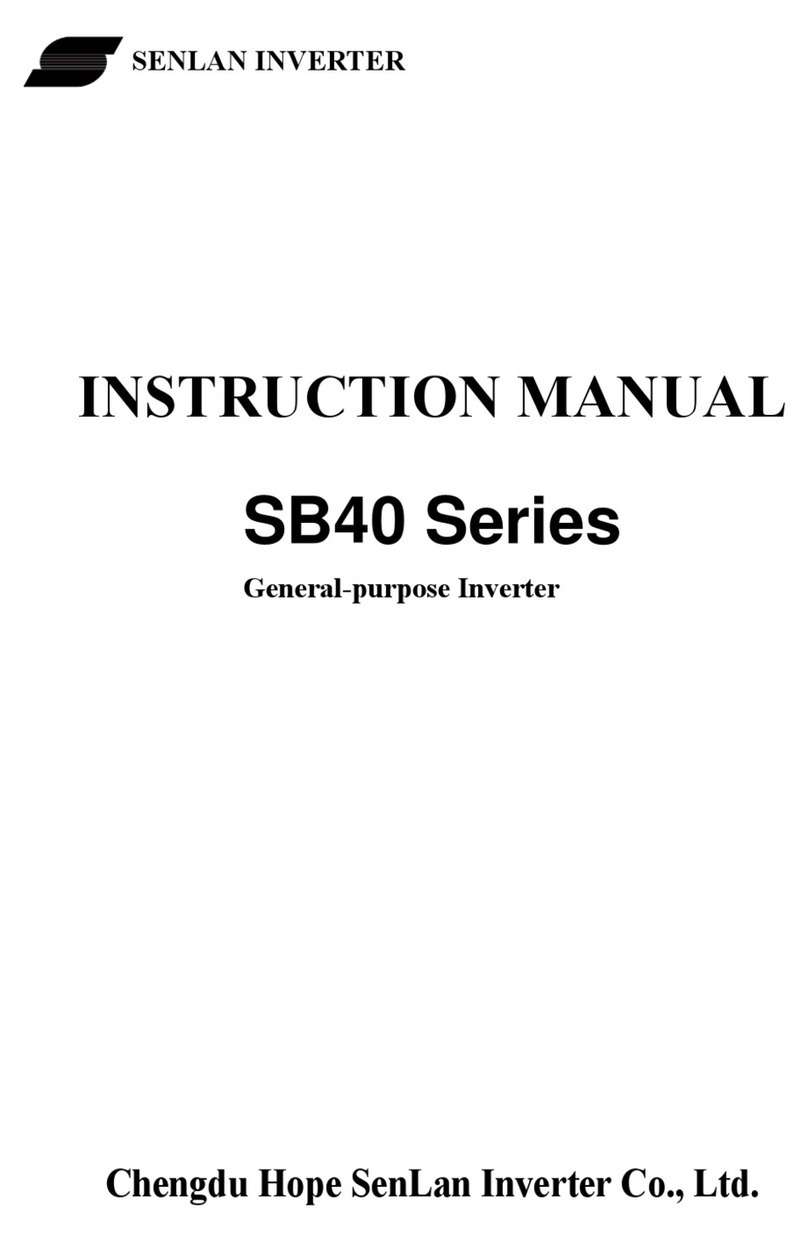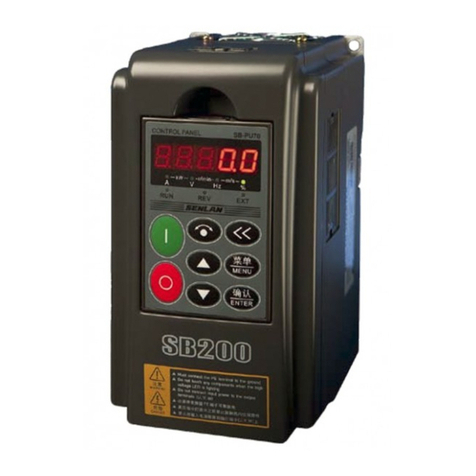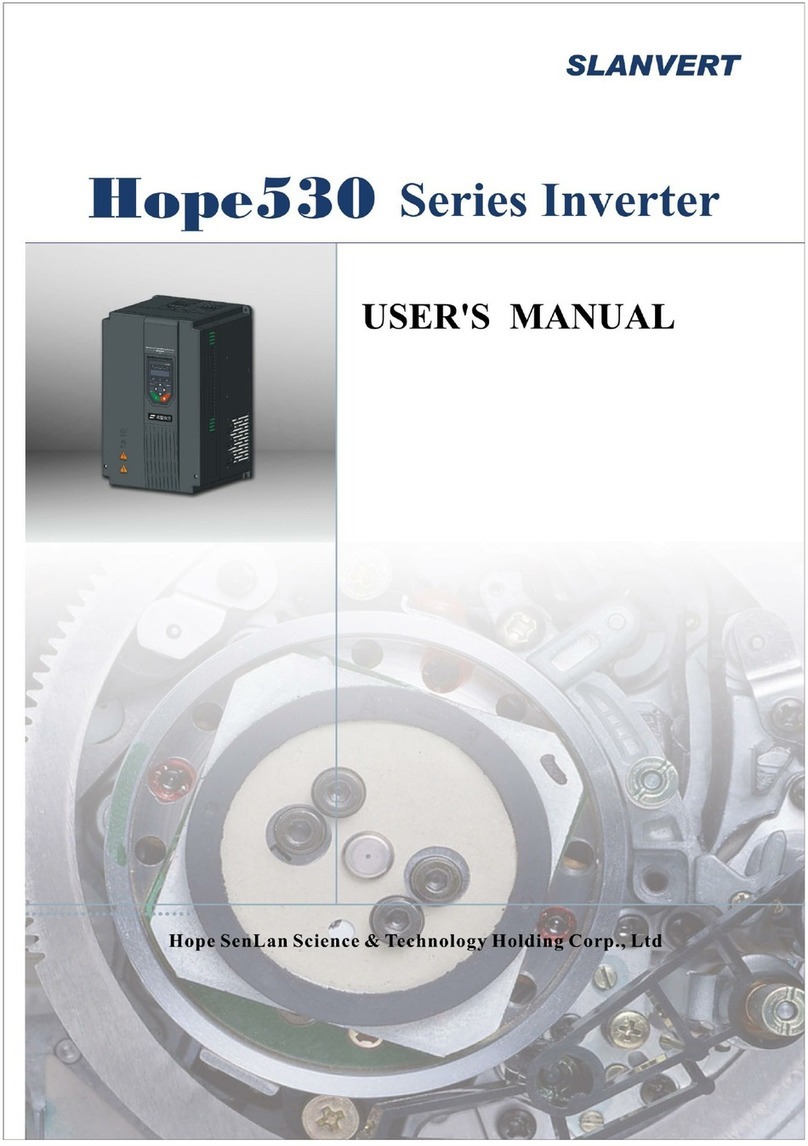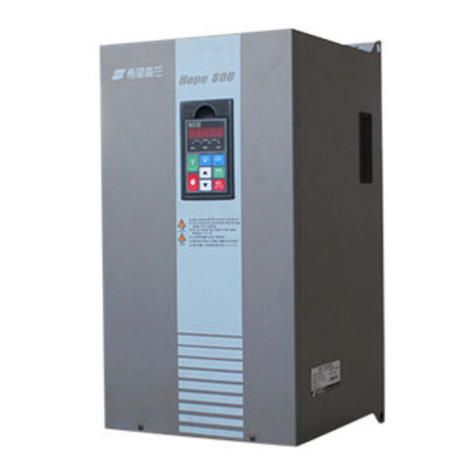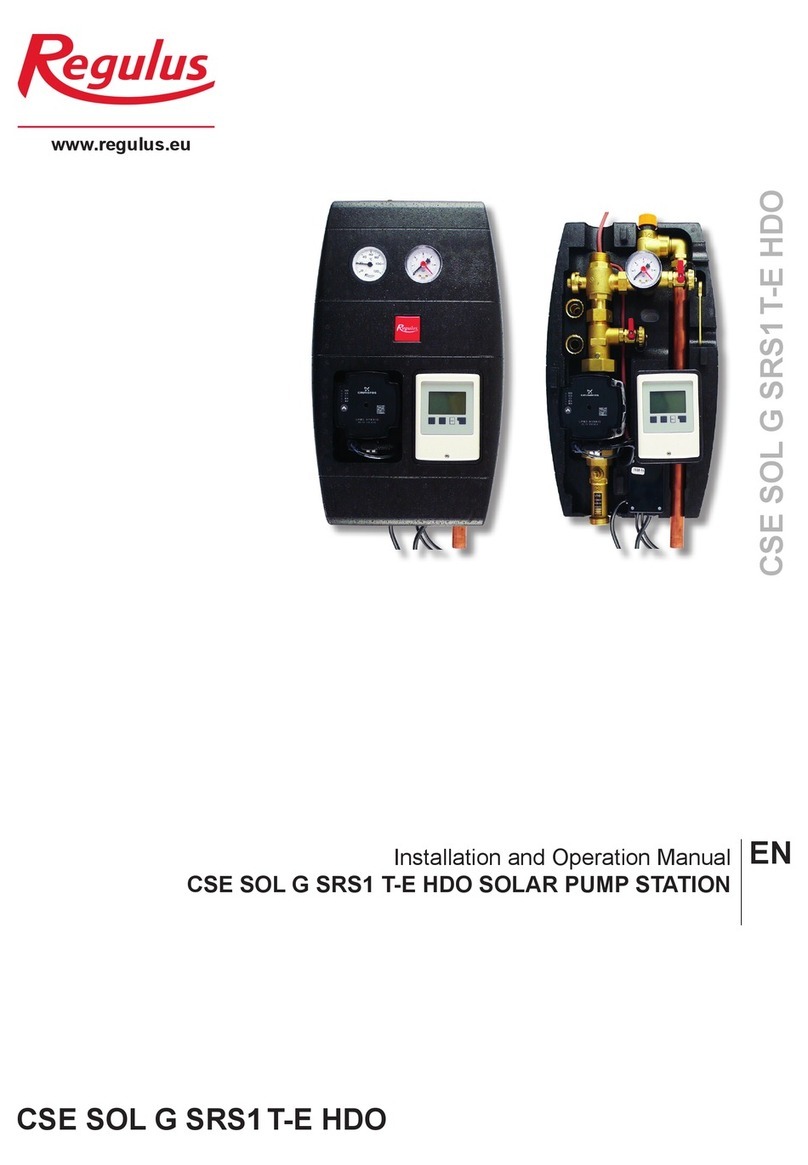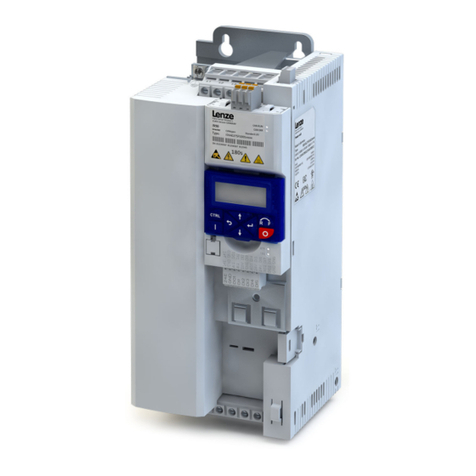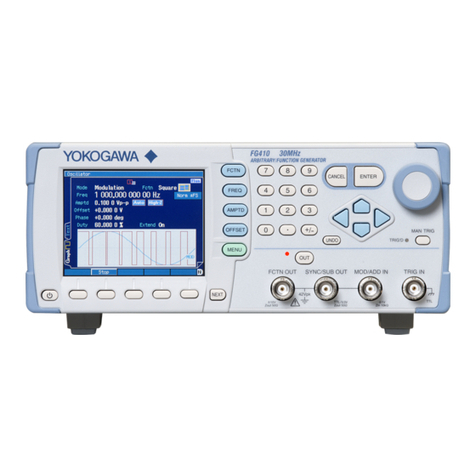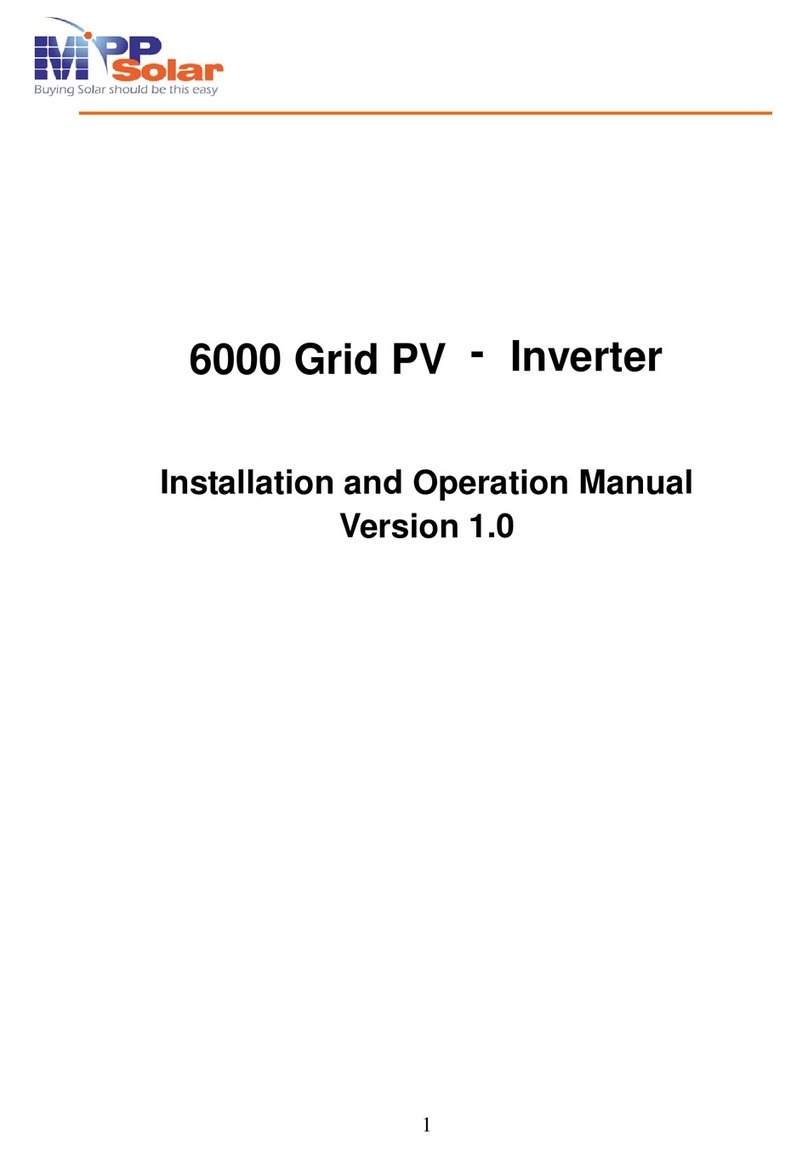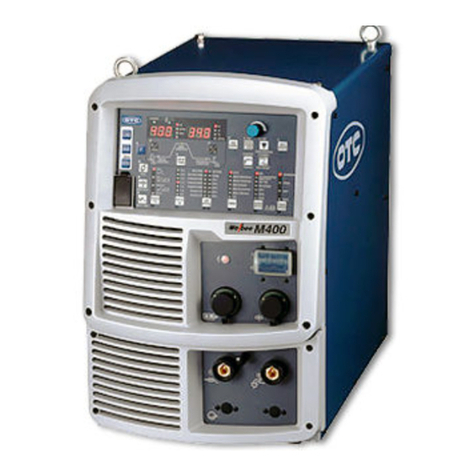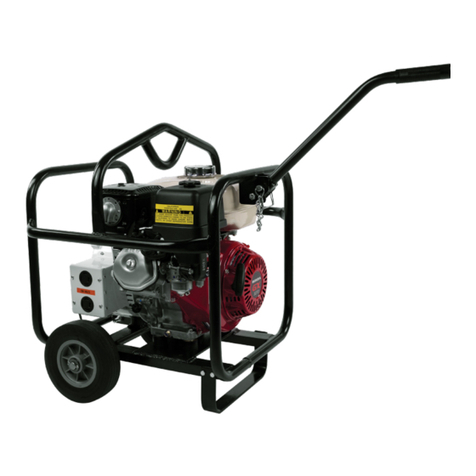Senlan SB150 Series User manual

SENLAN INVERTER
USER’S MANUAL
SB150 Variable Speed Drive
Hope Senlan Science & Technology Holding Corp., Ltd.

Table of Contents
Preface ............................................................................................................................1
1. Notes on Safety...........................................................................................................3
1.1 Notes on Safety............................................................................................................................... 3
2 Specifications...............................................................................................................7
2.1 Common specifications for SB150 series ....................................................................................... 7
2.2 Product series................................................................................................................................... 8
4 Operation and commissioning .................................................................................20
4.1 Operation and display....................................................................................................................20
4.3 Quick and optimize commissioning.............................................................................................. 23
5 Parameter table.........................................................................................................25
7 Troubleshooting.........................................................................................................69
7.1 Faults and remedies ....................................................................................................................... 69
7.2 Alarms and remedies ..................................................................................................................... 71
7.3 Operation faults and remedies.......................................................................................................72
8 Maintenance andAfter-sale Service ........................................................................73
8.1 Daily maintenance.........................................................................................................................73
8.2 Replacement of parts .....................................................................................................................74
8.3 Storage of the inverter ................................................................................................................... 74
8.4 After-sale service........................................................................................................................... 74

Preface
1
Preface
Thank you for selecting Senlan SB150frequency inverter series.。SB150 is a compact inverter adopting the
optimized high-performance space vector control VVVF arithmetic and featuring elegant appearance, delicate
circuit design, ingenious circuit design, simple and practical functions, and reasonable menu arrangements, which
supports numerous advanced functions, e.g. auto torque boost, slip compensation, oscillation suppression, tracking
startup, stall prevention, precise deadband compensation, auto voltage stabilization, process identification and
auto carrier frequency adjustment.,the series are suitable for most industrial control applications.
This manual provides the user with a guide on installation & wiring, parameter setting, daily maintenance, fault
diagnosis and troubleshooting. The user is required to peruse the whole content of the manual carefully and be
familiarized with the relevant know-how and notes on inverter safety before any attempts of installation, setting,
operation and maintenance.
The technical specifications applied to this product or the content of this manual may be subject to any change
without prior notifying.
This manual is required to be kept properly until the inverter is out of its service life.
Items to Be Checked on Opening the Packing Case
The user is required to carefully check and confirm the following items on opening the packing case. If you have
any problem, don’t hesitate to contact us or your supplier for a solution.
What to Confirm How to Confirm
Is the inverter identical with the
product you’ve ordered?
Check if the nameplate inscriptions on the side of the inverter comply
with the requirements in your order
If there is any damages on the
product?
Check the overall appearance of the product to see if there are any
damages arising from transportation
Inverter Model Description
Senlan Inverter
SB150 Serie
1.5KW
T:3phase S:1phase
4:400Class 2:200VClass
A: Digital IO+Analog Interface Board
C:Digital IO+Communication Module
D:Digital Interface Board
F:Analog Interface+Digital Interface+Communication
Interface
None:Interface Board WithoutTerminal
E:Built-in EMC Filter
None:Without EMC Filter
Inverter Nameplate Inscriptions(Instance:SB150-1.5T4E-F)

Preface
2
SENLAN INVERTER
Hope Senlan Science and Technology Holding Co.,ltd
SLANVERT
Definition of Safety ID Markings
Any safety-specific content of this manual may use the following markings for identification. The user is required
to follow the instructions of the content identified with safety markings.
CAUTION: Any wrong operation or against the instructions may cause inverter damage or personal
injury/fatality.
CAUTION: Any noncompliant operation may cause abnormal system operation which, in serious
cases, may induce inverter damage or mechanical damage.

1 Notes on Safety
3
1. Notes on Safety
1.1. Notes on Safety
(1) Installation
The inverter must not be installed at places with combustibles or in the vicinity of combustibles;
otherwise there may cause fire.
The inverter must not be installed in an environment exposed to flammable gases; otherwise There
may cause explosion.
(2) Wiring
Confirm that the positive/negative busbar voltage is below 36V; otherwise there may be a risk of
electric shock.
Confirm that no wiring operation is permitted unless the power supply is thoroughly disconnected;
otherwise there may be an electric shock hazard.
Do not try to connect the DC terminals (DC+、DC-) directly with a dynamic braking resistor;
otherwise there may be a fire hazard.
The terminal voltage of the power supply must not exceed the rated voltage; otherwise there may be
inverter damage.
The grounding terminal (PE) of the inverter must be securely connected to earth (resistance to
earth≤10Ω); otherwise there may be a risk of electric fire.
(3)Check before switching on the power
Close the cover board of the inverter before turning on the power; otherwise there may be a risk of
electric shock or explosion.
Before trying to run the motor at a frequency over the rated motor frequency, conform that the
motor and the mechanical devices can endure such a high speed.
(4)Precautions on power and operation
Check to see if parameters are set appropriately before commissioning.
Do not open the front cover while the input power is switched on, for the high voltage inside may
cause electric shock.
Do not handle the inverter with wet hands. That may lead to electric shock.
“Power-on auto start” is enabled before shipment from the factory. When the terminal control and
the run signal are valid, the inverter will start automatically once the power is turned on.
Do not control the run and stop of the inverter by switching on and off the input power.
Related parameters should be reset after parameter initialization.
If the function of restart has been set (such as auto-reset or restart after momentary power failure),
do not approach the motor or mechanical load while the inverter is waiting to restart.

1 Notes on Safety
4
(5)Precautions on transport and package
Do not place more inverters than specified in the packaging box.
Do not put any heavy object on the inverter.
Do not open the cover board during transport.
Do not apply any force on the keypad and the cover board while handling the inverter, otherwise
there may be a risk of injury to people or damage to equipment.
(6)Disposal
Dispose the inverter as industrial waste.
The electrolytic capacitors inside the inverter may explode while burned.
Plastic components of the inverter will generate toxic gases while burned.
1.2 Other precautions
(1)About motor and mechanical load
Comparison with commercial power operation
SB150 inverter is a voltage-type PWM motor drive. Its output voltage contains some harmonics. Compared
with the commercial power, it creates more loss and noise and leads to higher temperature rise of the motor.
The insulation withstands voltage of the cables and motor should be taken into account when the input
voltage is high or the motor cables are long.
Constant-torque, low-speed operation
When a common motor runs at low speed for a long time, the motor temperature will rise due to the
weakening cooling effect. So if a motor is required to operate at low speed and constant torque for a long term, an
inverter or the forced air cooling method must be used.
Running above 50Hz
If you plan to run the motor over 50Hz, be aware that the vibration and noise will increase and make sure that
the motor bearings and mechanical devices can withstand such a high speed.
Lubrication of mechanical devices
While running at low speed for a long period, such mechanical devices as gearbox and gears may be
damaged due to worsening lubricating effect. Before you run them, check the lubrication conditions.
Load of regerative torque
Regerative torque often occurs while a load is hoisted, and the inverter often stops due to overvoltage
protection. In this case, an appropriate braking unit should be selected and installed.
Mechanical resonant point
Certain output frequencies of the inverter may be the mechanical resonant points. To avoid these points,
place anti-vibration rubber under the base of the motor or setting the jump frequencies.
Motor insulation check before connected to the inverter

1 Notes on Safety
5
When the motor is used for the first time or reused after it has not been used for a long period, the motor
insulation must be inspected to prevent the damage to the inverter cause by the failed insulation of the motor
windings. Use a 500V voltage-type megaohm meter to measure the insulation resistance, which should not be
less than 5MΩ.
DANGER:While performing the insulation test on the motor, be sure to disconnect the motor with the
inverter, otherwise the inverter will be damaged.
DANGER:Do not perform the voltage resistance test and insulation test on the control circuit,
otherwise the circuit elements will be damaged.
(2) About inverter
Capacitor or voltage-dependent resistor for improving power factor
As the inverter output is of PWM voltage type, the capacitor or voltage-dependent resistor(for improving
the power factor) installed on the output side of the inverter will lead to inverter trip or damage to
components. Do remove the capacitor or the voltage-dependent resistor before using the inverter.
Frequent start and stop
For applications where frequent start and stop are needed, terminals are recommended for the control of the
start/stop of the inverter. Using the switching device(such as contactor) on the inverter input side to start or
stop the inverter frequently is prohibited. That may destroy the inverter.
Using the inverter beyond the rated value
It is not recommended to operate the inverter beyond the range of the allowable input voltage. If the inverter
has to be used beyond the range, increase or decrease the voltage via a voltage regulator.
Lightning protection
With the built-in protection of overvoltage from lightning, the inverter has certain self-protection ability
against the lightning strike.
Leakage protector
The high-speed switching operation during the running of the inverter will generate high-frequency current
that sometimes causes the mis-operation of the leakage protection circuit. To address this issue, moderately
lower the carrier frequency, shorten the wires or install a leakage protector.
Observe the following points while installing the leakage protector.
1) The leakage protector should be installed on the inverter input side, preferably behind the air
switch(non-fuse circuit breaker).
2) The leakage protector should be one that is insensitive to higher harmonics or specially designed for the
inverter(sensitivity above 30mA). If a common leakage protector is selected, its sensitivity and action time should
be greater than 200mA and 0.2s, respectively.
Derate of inverter
a) If the ambient temperature exceeds 40℃, the inverter should be derated by 5% for every 1℃
increase, and external forced cooling should be provided.

1 Notes on Safety
6
b) If the altitude is above 1000 meters, the inverter should be derated by 1% for every 100m rise
c) .If the carrier frequency is greater than the factory setting, the inverter should be derated by
5% for every 1 kHz increase.

2Specifications
7
2 Specifications
2.1 Common specifications for SB150 series
Item Description
Rated voltage and
frequency
3-phase: 220v/380V,50/60Hz
Input
Allowable range Voltage: 320~420V; voltage imbalance<3%; frequency:47~63 Hz
Output voltage 3-phase, 0V~input voltage, with the error less than 5%.
output Output frequency
range
V/F control: 0.00~650.00Hz
Vector control: 0.00~200.00Hz
Overload capacity 150%of rated current for 1 minute
Frequency
resolution
Digital reference: 0.01Hz Analog reference: 0.1%of max. frequency
p
erformance
standard
Output frequency
precision
Analog reference: :±0.2%of max. frequency(25±10℃)
Digital reference: 0.01Hz
Communication Built-in RS485 port, supporting Modbus protocol
Analog input AI 2 channels AI(also used as digital input),voltage or current type, positive or
negative, with drop detection
Analog output AO 1 channels AO,voltage or current type independent terminal to choose
Digital input 5 channels of multi-function digital input(two of them are analog inputs),
sampling period 1ms
Control
terminal
Digital output 1 channel of NPN multi-function digital output,1 channels of multi-function
relay output
Motor control
mode
Space vector V/F control, with auto torque boost and slip compensation
Command source Keypad, terminal and communication. They can be switched over by terminals
Frequency
reference source
Keypad(keys and POT), communication, UP/DOWN value, AI1, AI2 and PFI.
Auxiliary frequency reference can be introduced for fine tuning
V/F curve Linear curve and two reduced-torque curves, with manual and auto torque
boost
Dynamic braking Built-in braking unit and external braking resistor
DC braking Braking time: 0.0~60.0s
Braking current: 0.0~100.0%of rated current
Accel/decel Linear or S-curve acceleration/deceleration
Jog Jog frequency: 0.10~50.00Hz
AV R Keeps the output voltage constant automatically when the voltage of power grid
fluctuates
Auto carrier
regulation
Carrier frequency is regulated automatically based on the load characteristic
and ambient temperature
Momentary power
failure
Ensures uninterrupted operation by controlling the DC link voltage
Process PID process PID adjustor, can do 4 references, can disable terminals, and provide
PID revise mode, sleep function (suit for water supply industry)
Wobble Ensures even winding of textiles
Multistep
frequency
7 multistep frequencies.,selected by digital input terminal.
Software
function
others Smooth start, stall prevention, zero-speed delay, oscillation suppression,
deadband compensation
Protection functions Overcurrent, overvoltage, undervoltage, input/output phase loss, output
short-circuit, overheating, motor overload, external fault, analog input

2Specifications
8
Item Description
disconnection, stall prevention, etc.
Options Braking resistor、input/output reactor、EMI filter、Profibus-DP module、remote
control box、LCD keypad etc.
Service site
Altitude less than 1000 meters; indoor; no direct sunlight; free of dust,
corrosive gases, inflammable gases, oil mist, water vapor, water drops, salt
mist, etc.
Temperature/humid -10~+40 /20℃~90%RH, no condensation
Storage
temperature
-20~+60℃
Ambient
Vibration Less than 5.9m/s2(0.6g)
Protection degree IP20
Structure Cooling method Forced air cooling, with fan control
2.2 Product series
SB150 inverter rated value is as follows:
Model Rated capacity(kVA)Rated output current
(A)
Applicable motor
(kW)
SB150-0.4S2 1.1 3 0.4
SB150-0.75S2 1.7 4.5 0.75
SB150-1.1S2 2.3 6.0 1.1
SB150-0.4T2 1.1 3 0.4
SB150-0.75T2 1.9 5 0.75
SB150-1.5T2 2.8 7.5 1.5
SB150-0.4T4 1.0 1.5 0.4
SB150-0.75T4 1.6 2.5 0.75
SB150-1.5T4 2.4 3.7 1.5
Outline drawings of model type SB150-0.4~SB150-1.5
Inverter Outline Drawing

4 Operation and commissioning
20
4 Operation and commissioning
4.1 Operation and display
4.1.1 Functions of keypad
The keypad is used to set or browse parameters, control operations, display error information and so on. The
appearance of the keypad is as follows.
-+
Status light Unit light
Operation key run Stop key stop fault reset
Description of keys on the keypad:
Key Name Function
Menu/Enter 1、Enter each menu
2、Data storage confirmation
Shift /Exit
1、Select the data digit to be modified; switch
between monitored parameters
2、Under the status of parameter modification
and return to the previous menu.
3、Constantly press 3 seconds and return to the
previous menu.
Decrease number
(-)Key
-+
Increase number
(+)Key
Inc/Dec number or data
Description of keys on the keypad:
Indicators Unit Indicators Unit Indicators Unit
Hz
A
V

4 Operation and commissioning
21
Indicators Unit Indicators Unit Indicators Unit
r/min
m/s
%
Meanings of three indicators status
Indicator Status Inverter state
Off Standby state
On Stable run state
RUN indicator
Blinking Accelerating or decelerating state
Off Both preset and current direction are forward
ON Both preset and current direction are reverse
REV indicator
Blinking Preset direction is inconsistent with current direction
Off Keypad control
ON Terminal control
EXT indicator
Blinking Communication control
4.1.2 Display status and operation of keypad
The keypad of SB150 has the following display status: monitoring status(including in standby state and in run
state), parameter editing status, fault display status, alarm display status, etc.
Monitoring
status 1st-level menu 2nd-level menu
Press 3secs quit
Display monitored
parameters cyclically
Press 3secs quit
Select digit to be
modified
Inc/Dec parameters value
Select digit to be
modified
Monitoring status in standby state
Pressing in this status cyclically displays the standby-state parameters(defined by FC-01~FC-04)
Monitoring status in run state
Pressing in this status cyclically displays the run-state parameters(defined by FC-01~FC-07)

4 Operation and commissioning
22
Parameter editing status
In monitoring status, pressing enters the editing status, which contains second level menus: parameter
group number→serial number in parameter group→parameter value. Pressing enters the next menu and
pressing 3 second, returns to the previous menu(returns to monitoring status if at the first level menu).
Pressing change the parameter group numbers, serial numbers in parameter group or parameter values. .
Under the second level menu, the digit which can be edited blinks. Pressing switches the digit to be
edited to another digit, and pressing saves the modified data and returns to the first level menu, and the
next parameter is displayed.
Password check status
If there is a user password(F0-12 not equal to zero),before you can edit any parameter you enter the password
check status and “――――” is displayed. Input the password with 、 (“――――” is displayed
during input)and press If the password is not correct, “Err” blinks. At this moment, press
returning to the password check status and press again exiting the password check status. If there is no
any keystroke within ten minutes, the password protection will take effect automatically.
Fault display status
Once the inverter detects a fault signal, the keypad enters the fault display status, and the error code blinks. The
fault can be reset by inputting reset command ( key, control terminal or communication command). If
the fault still exists, the error code continues to blink, during this period you can modify related parameters to
eliminate the fault.

4 Operation and commissioning
23
Alarm display status
When the inverter detects the alarm information, the alarm code blinks. If there are multiple alarm signals, the
alarm codes display alternately. The alarm information can be temporarily hidden by pressing or
. The alarm signal is automatically removed if normal state is recovered. The inverter does not stop in
alarm display status.
4.2 Switching on the power for the first time
Connect the wires in accordance with the technical requirements specified in section 3.4.
After checking the wiring and power supply, close the air switch of the AC power on the inverter input side.
“8.8.8.8.8” will fist be displayed on the keypad of the inverter. When the contactor inside the inverter is closed
normally, the display becomes the reference frequency. This shows the inverter initialization has been completed.
If anything unusual occurs when the power is turned on, disconnect the air switch and check and remove the error.
4.3 Quick and optimize commissioning
SB150series inverter is controlled by keypad, the frequency setting is digital setting, refer to 3.4.1 to check the
terminal function
Below is some common and necessary settings of SB150 inverter besides default setting.
1、Frequency setting channel and reference frequency: refer to page 37;
2、Command source: refer to F0-02, page40;
3、Maximum frequency, upper-limit frequency lower-limit frequency and max. output voltage : refer to F0-06,
F0-07, F0-08 and F2-10, make sure F0-06≥F0-07>F0-08.
4 Motor run direction: refer to F0-05, page38;
5、Accel/decel time: the accel/decel time should be as long as possible. Too short time will cause overcurrent
or overlarge torque which damages the load, refer to page39;
6、Start and stop mode: refer to F1-04 and F1-08, page 42;
7、Motor parameters: rated power, motor pole number, rated current, rated frequency, rated speed and rated
voltage. Refer to page 44。
SB150 optimize commissioning:
1、F2-00“Manual torque uprising amplitude”: If the current at the start is too large, reduce the value, refer
to page 42;
2、It is recommended to boost the torque automatically in order to increase the inverter’s starting torque and
its output torque at low speeds.,refer to page 42
3、Slip compensation can ease the speed drop caused by the load. It is only valid when “auto torque boost” is
valid, refer to page 43;

4 Operation and commissioning
24
4、Vibration damping: If the motor vibrates, increase this parameter gradually until the vibration disappears.
Refer to F2-06.

5 Parameter table
25
5 Parameter table
Note: In the “Change” column of the table below, “O” indicates the parameter can be changed in any state, “×”
indicates the parameter is only changeable in running state, while “△” indicates the parameter is read only.
F0 Basic Parameters
No. Name Setting range Default Chan
ge page
F0-00 Digital reference
frequency 0.00~650.00Hz 50.00Hz ○37
F0-01 Main reference
channel
0:F0-00digital setting
2:AI1
4:UP/DOWN value
1:Communication
3:AI2
5:Keypad POT
0 ○37
F0-02 Command source
1:Keypad
2:Terminal,invalid
3:Terminal,valid
4:Communication,invalid
5:Communication,valid
1 ×37
F0-03 Frequency holding
0: Saved upon power loss
1: Restored to F0-00 upon power loss
2: Restored to F0-00 upon power loss or stop
Note: For keypad digital potentiometer, revise by
or communication setting
0 ○38
F0-04 Auxiliary reference
channel
0:None 1:Communication setting
2:AI1 3:AI2
4:UP/DOWN value
0 ○38
F0-05 Direction lock 0: Forward or reverse 1: Forward only
2: Reverse only 0 ○38
F0-06 Max. frequency 0.00~650.00Hz 50.00Hz ×38
F0-07 Upper-limit frequency 0.00~650.00Hz 50.00Hz ×38
F0-08 Lower-limit frequency 0.00~650.00Hz 0.00 Hz ×38
F0-09 Inverter rated capacity Min. unit:0.01kW
Depend
s on
model
△38
F0-10 Software version 0.00~99.99
Depend
s on
version
△38
F0-11 Parameter
initialization 11:initialization 22:clean fault log 00 ×38
F0-12 User password 0000~9999,0000 means no password 0000 ○38

5 Parameter table
26
F1 Accel/decel, start, stop and jog parameters
No. Name Setting range Default Cha
nge Page
F1-00 Accel time 1
F1-01 Decel time 1
F1-02 Accel time 2
F1-03 Decel time 2
0.1~3600.0s
Acceleration time: time period over which the
frequency rises by 50Hz.
Deceleration time: time period over which the
frequency drops by 50Hz.
Inc/Dec time 2 is also be used as jog Inc/Dec
time.
6.0s ○39
F1-04 Starting mode 0:Start from starting frequency 1:Start
from searched speed 0 ×39
F1-05 Starting frequency 0.00~60.00Hz 0.50Hz ○39
F1-06 Starting delay time 0.0~60.0s 0.0s ○39
F1-07 Starting frequency
duration 0.0~60.0s 0.0s ○40
F1-08 Stop mode 0: Slowdown stop 1: Coast stop
2: Slowdown+DC braking 0 ○40
F1-09 DC braking frequency (at
stop) 0.00~60.00Hz 0.50Hz ○40
F1-10 DC braking waiting time 0.0~10.0s 0.0s ○40
F1-11 DC braking / Zero-speed
delay time 0.0~60.0s 0.0s ○40
F1-12 DC braking current 0.0~100.0%,rated current is100% 50.0%○41
F1-13 Jog frequency 0.10 ~50.00Hz ,jog use the second set
Inc/Dec time. 5.00Hz ○41
F1-14 Accel/decel mode 0: Linear 1: S-curve 0 ×41
F1-15 S-curve accel start-stage
time 0.01~10.00s 0.20s ○41
F1-16 S-curve accel end-stage
time 0.01~10.00s 0.20s ○41
F1-17 S-curve decel start-stage
time 0.01~10.00s 0.20s ○41
F1-18 S-curve decel end-stage
time 0.01~10.00s 0.20s ○41
F2 V/F control parameters
No. Name Setting range Default Cha
nge Page
F2-00 Manual torque boost
level
0.0~15.0%Depends on
model ○42
F2-01 Manual torque boost
cut-off point
0.00~650.00Hz 50.00Hz ○42

5 Parameter table
27
No. Name Setting range Default Cha
nge Page
F2-02 Auto torque boost level 0.0~100.0%80.0%×42
F2-03 Slip compensation gain 0.0~300.0%0.0%○43
F2-04 Slip compensation
filtering time
0.1~25.0s 1.0s ×43
F2-05 Torque boost 0: No boost 1: Manual
2:Auto 3:Maunal+auto 1 ×43
F2-06 Vibration damping 0~200 20 ○43
F2-07 AVR function 0: Inactive 1: Active
2: Active except during decel 1 ×44
F2-08 V/F curve
0:Linear 1:Reduced-torque V/F curve 1
(1.5)
2:Reduced-torque V/F curve 2 (2.0)
0 ×44
F2-09 Base frequency 1.00~650.00Hz 50.00Hz ×44
F2-10 Max. output voltage 200V class:75~250V,default 220V
400V class:150~500V,default 380V
220V
380V ×44
F3 Motor parameters
No. Name Setting range Default Cha
nge Page
F3-00 Motor rated capacity 0.40~1.5kW Depends on
model ×44
F3-01 Pole number 2~16 4 ×45
F3-02 Motor rated current 0.5~7.5A Depends on
model ×45
F3-03 Motor rated frequency 20.00~650.00Hz 50.00Hz ×45
F3-04 Rated rotation speed 12.5~4000(x10)r/min Depends on
model ×45
F3-05 Motor cooling condition 0: Common motor
1: Inverter-controlled motor 0 ○45
F3-06
~
F3-09
Reserved
-
-- -
F4 Digital input terminals and multistep speed
No. Name Setting range Default Cha
nge Page
F4-00 X1/AI1 terminal 0
F4-01 X2/AI2 terminal 5
F4-02 X3 terminal
0:No signal
±1:Multistep frequency
1
±2:Multistep frequency
2
±3:Multistep frequency
3
±4:Accel/decel time
select
±14:3-wire stop
command
±15:Internal virtual FWD
terminal
±16:Internal virtual REV
terminal
±17:Accel/decel disabled
±18:Run command
switched to terminal or 6
×45

5 Parameter table
28
No. Name Setting range Default Cha
nge Page
F4-03 FWD terminal 15
F4-04 REV terminal
±5:External fault input
±6:Fault reset
±7:Jog forward
±8:Jog reverse
±9:Coast stop /
Operation disabled
±10:UP/DOWN
increase
±11:UP/DOWN
decrease
±12:UP/DOWN clear
±13:Process PID
disabled
keypad.
±19:Reference frequency
switched to AI1
±20:Multi-PID select 1
±21:Multi-PID select 2
±22 :Wobble frequency
injection
±23:Wobble state reset
Note :Plus sign
means low level is
valid, while minus
sign means high
level is valid
16
F4-05 Digital input terminal
anti-jittering time 0~2000ms 10ms ○45
F4-06 FWD/REV mode
0: 1-wire mode(start/stop)
1: 2-wire mode 1(FWD, REV)
2: 2-wire mode 2(start/stop, direction)
3: 2-wire mode 3(start, stop)
4: 4-wire mode(pulse type start/stop、direction)
5:3-wire mode 1(FWD, REV, stop)
6:3-wore mode 2(run, direction, stop)
1 ×45
F4-07 UP/DOWN regulation
mode
0: Level type(terminal) 1: Pulse
type(terminal)
2: Level type(keypad) 3: Pulse
type(keypad)
0 ○47
F4-08 UP/DOWN speed/step 0.01~100.00,unit is%/s or %1.00 ○48
F4-09 UP/DOWN memory
select
0: Stored on power loss
1: Cleared on power loss
2: Cleared at stop and on power loss
0 ○48
F4-10 UP/DOWN upper limit 0.0~100.0%100.0%○48
F4-11 UP/DOWN lower limit -100.0~0.0%0.0%○48
F4-12
~
F4-18
Multistep frequency 1~
7
0.00~650.00Hz
Note: The default values of multistep
frequencies 1~ 7are their respective frequency
code numbers, for example, the default value
of the multistep frequency 3 is 3.00Hz.
n.00Hz
(n=1~7) ○49
F5 Digital and relay outputs
No. Name Setting range Default Cha
nge Page
F5-00 Y1 terminal
0: Inverter ready
±1: Inverter running
±2: Frequency reach
±3: Frequency reach
±7: Restart after momentary
power failure
±8: Alarm output
±9: Reverse running
1 ×49

5 Parameter table
29
No. Name Setting range Default Cha
nge Page
F5-01 T1 relay output
detection signal
±4: Fault output
±5: Undervoltage
lockout
±6: Fault auto-reset
±10:Process PID sleep
±11: Wobble frequency
upper/lower limit
±12: Feedback exceed upper
limit alarm
±13:Feedback low lower
limit alarm.
Note: Set minus indicates
output negate
4
F5-02 T1 terminal closing
delay 0.000s
F5-03 T1 terminal opening
delay
0.000~65.000s
0.000s
○49
F5-04 Frequency reach
detection band 0.00~650.00Hz 2.50Hz ○50
F5-05 Frequency reach
detection level 0.00~650.00Hz 50.00Hz ○50
F5-06 Frequency reach
detection hysteresis 0.00~650.00Hz 1.00Hz ○51
F6 Analog and pulse frequency terminals
No. Name Setting range Default Cha
nge Page
F6-00 AI1 Min. input analog
quantity 0 ○51
F6-01 AI1 Max. input analog
quantity
0.00~100.0%
100.0%○51
F6-02
AI1 Min. input analog
quantity corresponding
set value/feedback value
0.00%○51
F6-03
AI1 Max. input analog
quantity corresponding
set value/feedback value
0~100.00%
Note: set frequency use max. frequency as
reference value.
PID setting/feedback use percentage of PID
reference scalar. 100.0%○51
F6-04 AI1 filtering time 0.000~10.000s 0.100s ○51
F6-05 AI2 Min. input analog
quantity 0 ○51
F6-06 AI2 Max. input analog
quantity
0.00~100.0%
100.0%○51
F6-07
AI2 Min. input analog
quantity corresponding
set value/feedback value
0.00%○52
F6-08
AI2 Max. input analog
quantity corresponding
set value/feedback value
0.00~100.00%
Note: set frequency use max. frequency as
reference value.
PID setting/feedback use percentage of PID
reference scalar. 100.0%○52
F6-09 AI2 filtering time 0.000~10.000s 0.100s ○52
This manual suits for next models
9
Table of contents
Other Senlan Inverter manuals
Popular Inverter manuals by other brands
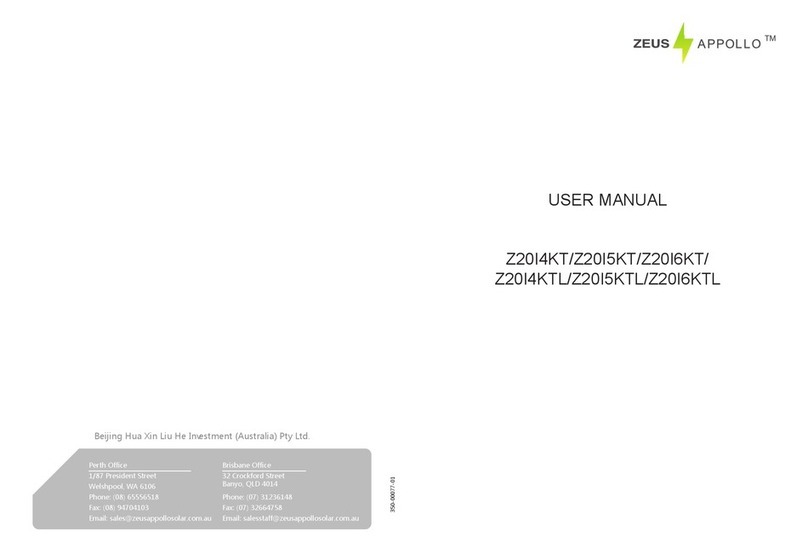
Zeus Appollo
Zeus Appollo Z20I4KT user manual
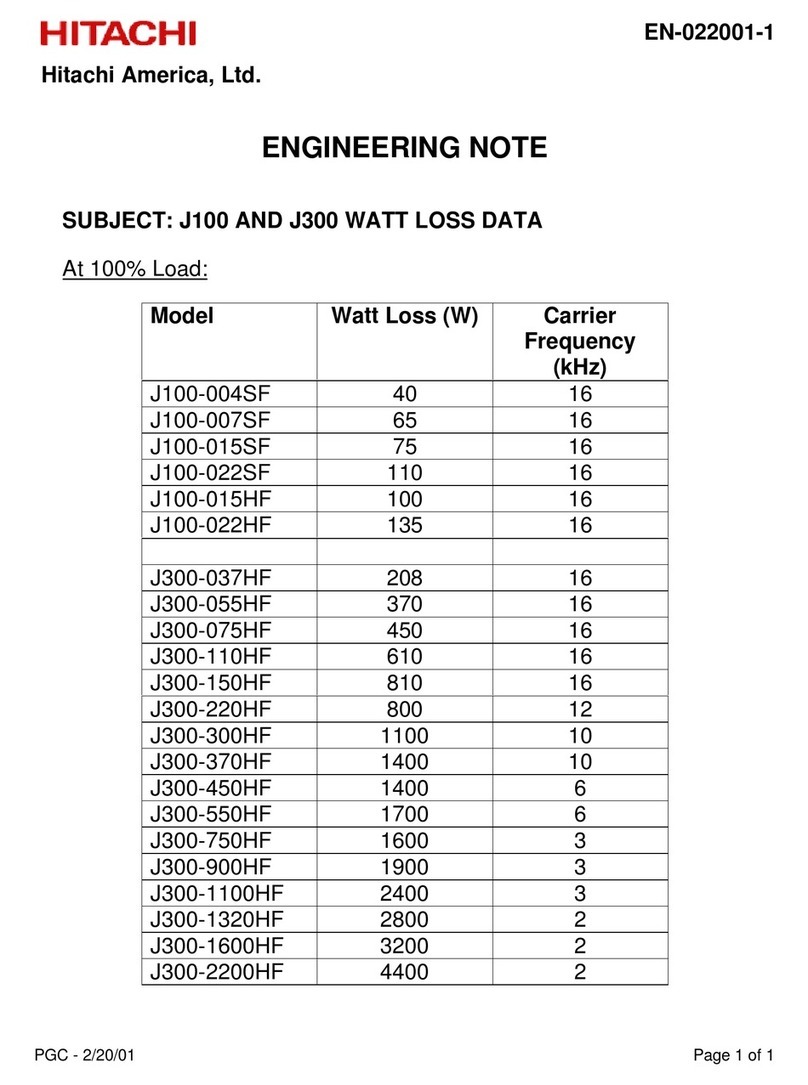
Hitachi
Hitachi J300 Series Engineering note
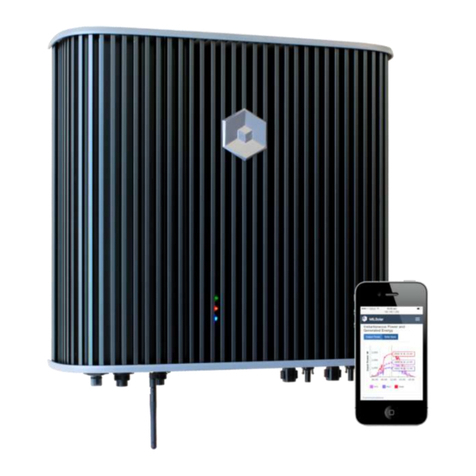
MIL-Solar
MIL-Solar Eclipse 5000-II Installation and operation manual
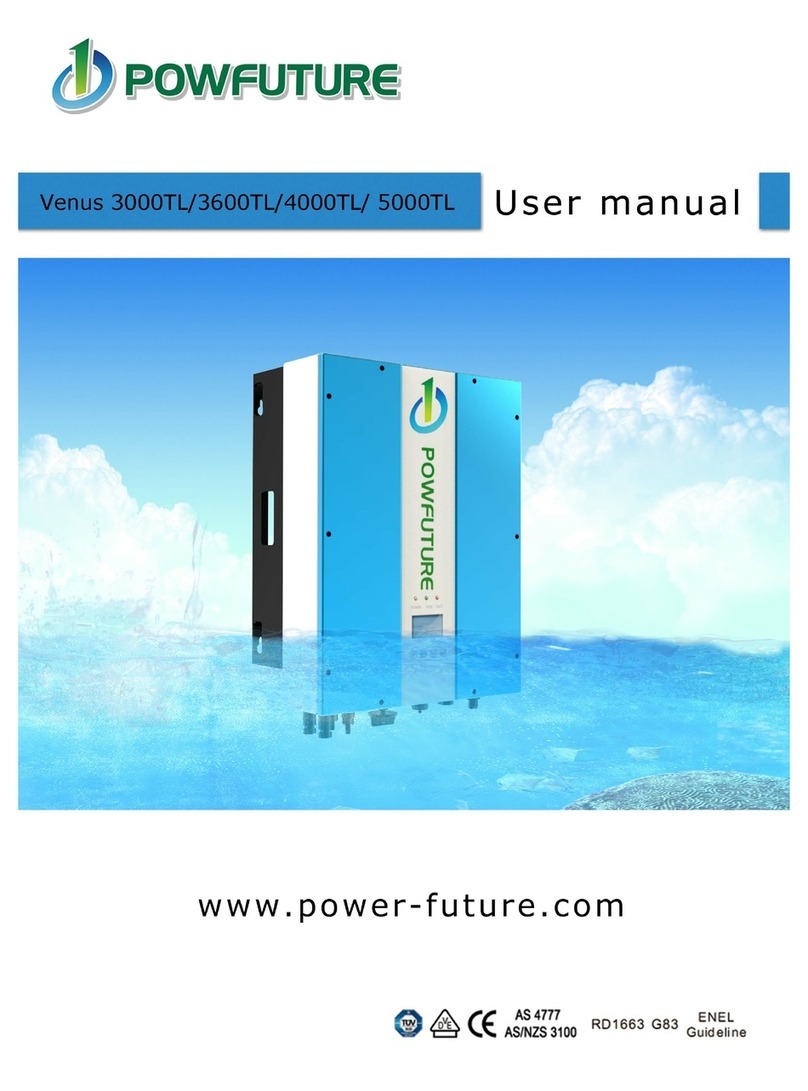
Powfuture
Powfuture Venus 3000TL user manual
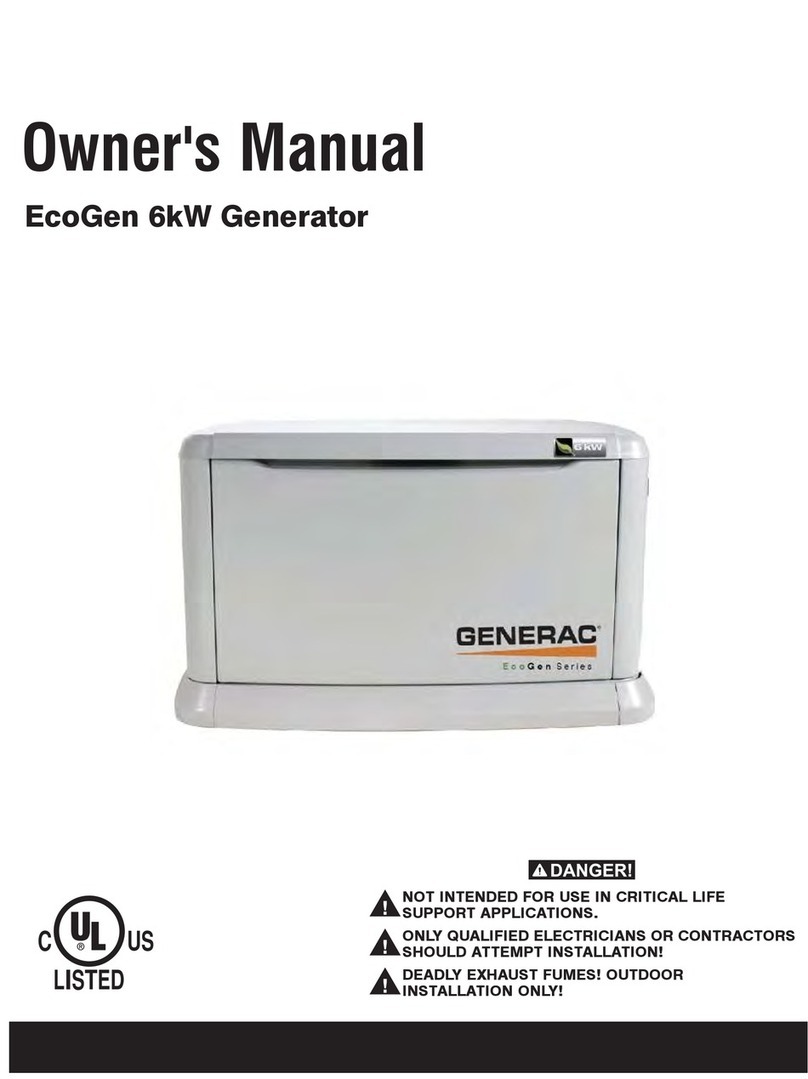
Generac Power Systems
Generac Power Systems ECOGEN SERIES owner's manual
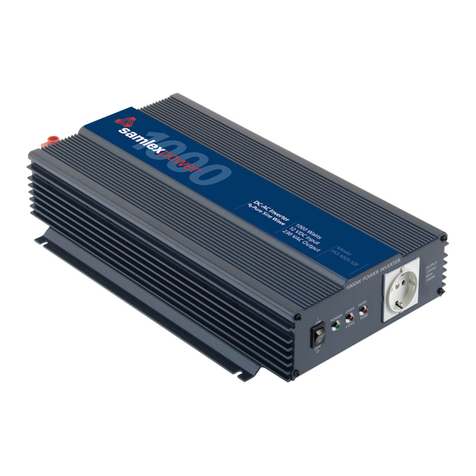
Samlexpower
Samlexpower 60S-12A instructions
